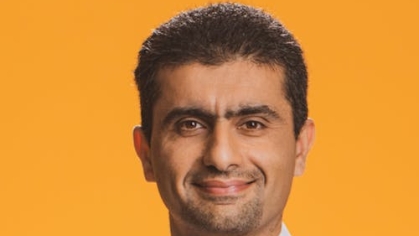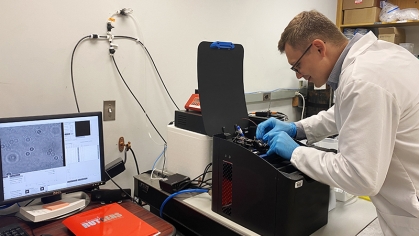Burlion and Labazzo Receive Provost’s Award for Teaching Excellence
This year, two School of Engineering faculty – Laurent Burlion, an assistant professor in the Department of Mechanical and Aerospace Engineering, and Kristen Labazzo, an assistant professor in the Department of Biomedical Engineering—were among the recipients of the Provost’s Award for Excellence in Teaching Innovations.
Praised for their innovative teaching practices that enhance student learning, they each received a $2,500 institutional award at the end-of-year Chancellor’s Celebration of Faculty Excellence. Labazzo and Burlion share the secrets of their teaching success.

What does it mean to receive this award?
Labazzo: As a teaching-focused professor of practice, the opportunity to be recognized for my contributions to my department is truly appreciated. I’m extremely grateful to my department for acknowledging the value I bring to the education of our students by nominating me for this award – and I was thrilled to learn I had received it!

Burlion: It’s an honor and a fantastic achievement. Before joining Rutgers two years ago, my teaching experience was very limited and I, therefore, spent a lot of time preparing for my first courses. I’m proud my effort has been recognized.
What led you to your fields?
Burlion: First, I was an electrical engineer specializing in control theory and became a fan of aerospace applications a bit late. I discovered aerospace when I joined Onera, the French Aerospace Lab in 2010 and moved to Toulouse, France – the center of Europe’s aircraft building industry. At the time, I worked with planes or satellites. Flight is now my passion!
Labazzo: I came to Rutgers for a doctorate in chemistry since that was my major and seemed the obvious path. However, I wasn’t finding satisfaction in that discipline, as I was seeking research with more medical and biological elements. I’d never heard of biomedical engineering before one day when I saw a flyer about a BME-sponsored seminar on tissue engineering an artificial artery. I went to that talk and it changed my life.
I switched to BME and had an amazing 10-year-run in industry prior to coming back to Rutgers as an educator. I give several talks on my career path to students, and the main point I emphasize is to just follow your passion. As long as you follow your heart, it will not steer you wrong and you will find immense career satisfaction. I’m living proof of that.
What most excites you about your field today?
Burlion: Aerospace engineering is evolving at a rapid pace. Charles Lindbergh flew nonstop from New York City to Paris less than a century ago – so imagine for just a second what our children or grandchildren could do.
Labazzo: BME is so diverse and I think that is in and of itself exciting – and we try very hard to keep up with current trends. Our students are using their problem solving skills to help people. They’re getting jobs at companies like Pfizer and Regeneron and working on COVID-19 vaccines, or working with major league baseball teams to perform biomechanical analyses of pitchers. What’s exciting is seeing where students end up and all the creative and unique ways they are leveraging their BME degrees.
Is there an engineering device you would like to see developed in the future?
Burlion: I believe the next generation of airplanes must and will be far more energy-efficient. Space exploration will also surely accelerate in the next decades. Recently the Mars helicopter Ingenuity was the first drone to fly on another plant. I’m convinced future missions will use more and more drones.
Labazzo: I truly believe that nothing is beyond the realm of possibility. I think that with enough creativity and further technological advancements, there won’t be any problem we can’t fix.
What kind of innovative approaches do you incorporate into your teaching?
Labazzo: I’m passionate about making teaching memorable and ensuring that students get a high-quality education while exploring topics that interest them. My biggest contribution has been the incorporation of patient, or person-centric, research. Biomedical engineers chose this field to apply problem solving skills to improving healthcare and quality of life, although we rarely get to engage with the end-users of the fantastic technologies coming from biomedical research.
Our collaborations with the Matheny Medical and Educational Center, a facility for severely physically-disabled individuals, and Operation Rebound, which supports disabled athletes, allow our students to interact with key stakeholders of innovation, whether they be end-users or caregivers.
Along the lines of incorporating “voice of customer” into education, my classes include guest speakers and field trips to give students a real-world perspective on the impact they can have as biomedical engineers. I also use show-and-tell to demonstrate certain principles. And YouTube videos and TED talks are a great way to break up the monotony of class – and can even be a major advantage for students. I’d shown a TED talk by noted tissue engineer Dr. Tony Atala in class, and a student accepted by Wake Forest used this as a talking point during her interview with him. Needless to say, she will be joining his lab in the fall.
Burlion: I mainly use projects and active learning methods to enhance learning outcomes.
For example, I recently proposed a new international drone course between Rutgers and CenraleSupélec, as part of the University of Paris Saclay. This course is a COIL – Collaborative Online International Learning activity and was run in parallel in France and at Rutgers. The project was called DAReTeach –Drone Arenas-based Remote International Teaching – and was selected by the FACE Foundation, which supports French and American cultural exchange in the arts and education.
We used active learning methods such as project-based learning, in small tutored groups, with the students working at home on small palm-sized, harmless “Crazyflie” drones that they could program to fly in order to understand better the theory taught in the course.
How do you approach teaching?
Burlion: There really is a link between my expertise in control theory and my teaching activities. In control, one uses feedback to better regulate a system. I believe we must constantly use student feedback to adapt our courses in real time. Technology is moving faster and faster and we have to keep our teaching material relevant, even if the fundamentals are the same.
Working with students is always a valuable and rewarding experience that helps me better explain and improve my own understanding of a subject, even when teaching basic concepts.
Labazzo: My teaching philosophy is: teaching must be memorable to be effective, material should be relatable, and respect has to be established – and that is a two-way street. If students know you care about them, they tend to work harder.
Did the pandemic restrictions prompt you to develop any new approaches to teaching?
Labazzo: Well, given my show-and-tell and the immersive experience that is part of patient-centric research, I definitely had to pivot. But I tried to stay as true to my teachings as possible. I still did show-and-tell whenever possible, asking students to find different objects around their houses and describe their material properties and why they were needed for the object’s function. One student told me he couldn’t look at anything in his house the same way without thinking about biomaterials.
For research, we couldn’t go into the Matheny hospital nor could we interact with the athletes, but we had a lot of Zoom meetings. Ultimately, all seven of my senior design teams this year managed to make amazing prototypes.
Burlion: In March 2020, my drone laboratory was shut down and international exchanges and travel were canceled. I had to find a creative way to continue working on drones and developing my collaboration with foreign universities. Fortunately, a few weeks later the American foundation FACE launched a fund to support virtual French-American collaborations like my international COIL course.
What do you most enjoy about teaching?
Burlion: I love interacting with my students and doing my best to transmit my passion and enthusiasm to them.
Labazzo: The students, hands down. They make me feel like I am truly having an impact. I have these opportunities to influence these students, to make or break their passion for BME, to help them get their first industry or research experience that could define their future paths. I love all my students – and I take my responsibility as an educator seriously.
What do you hope your students take away with them after they graduate?
Labazzo: I hope they appreciate their education, whether they enjoyed all of it or not. Everything is a lesson; whether they actually apply material from their classes in their jobs or learned coping skills from a disappointing class or team project. I hope they also keep open minds about where they can learn from. Trying to land what they think is a dream job may deter them from a truly amazing opportunity.
Burlion: Besides the theoretical knowledge acquired during class, I hope they will remember that most of the time most problems are incrementally and rigorously solved. I hope my students will think about my “step-by-step” approach, that prevents them from going too fast and being quickly stuck in a bottleneck.
Last summer, I received an email from a student who was pleased to apply what I had taught in my aircraft flight dynamics course in spring 2019 to her experience as an intern at Sikorsky.


